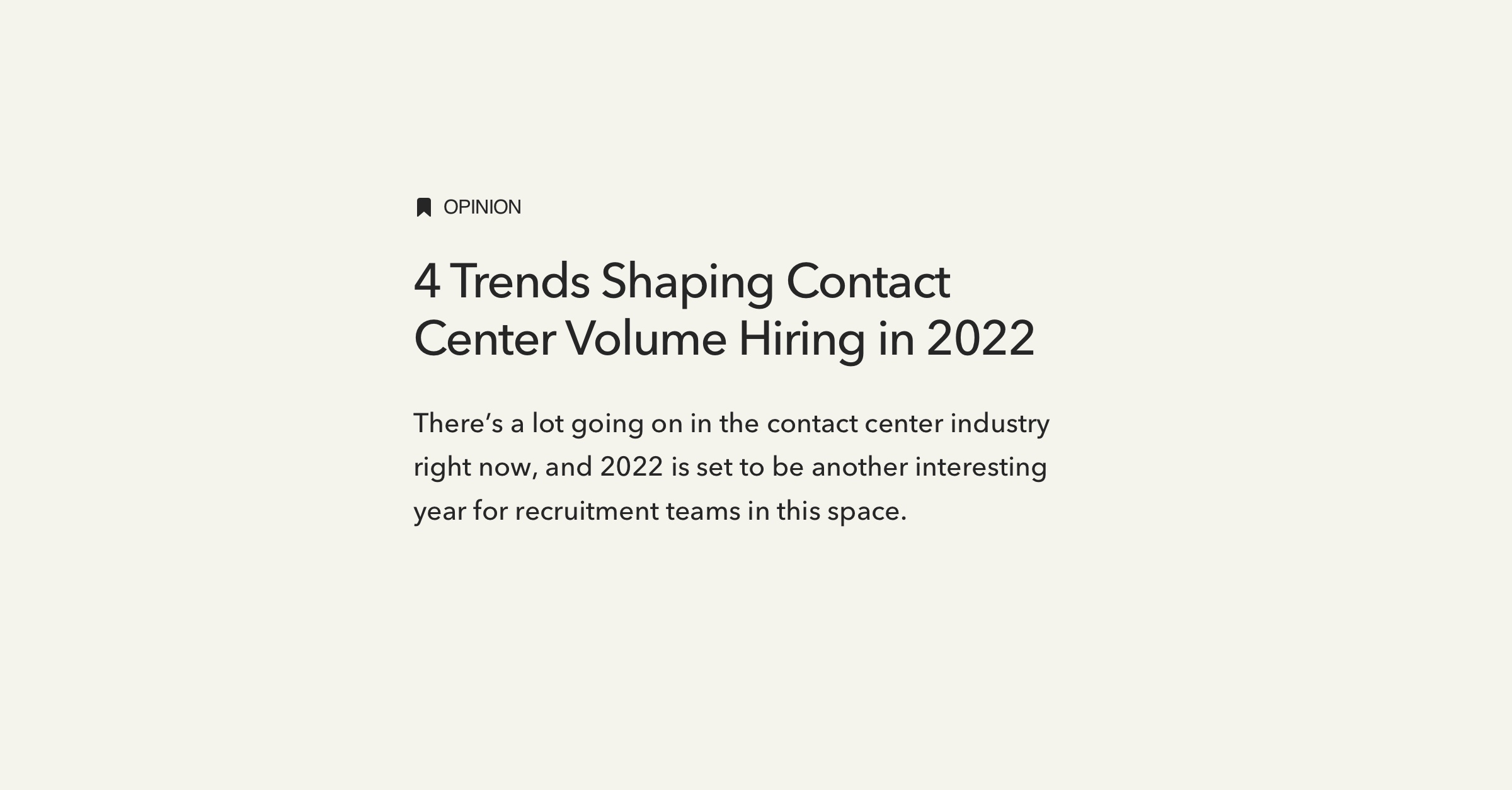The demand for contact centers continues to increase: Recent reports indicate that the industry is growing at 16% annually. For contact center talent acquisition and operational leaders, growth in demand combined with global labor challenges are creating severe pressure to meet hiring demands.
Although high-volume hiring has always been challenging, changing labor markets and increasing labor costs are putting pressure on BPOs and internal contact center operations to review their recruitment strategies.
Last year in our contact center hiring trends, we discussed that recruitment teams would need to focus on digital transformation and reducing agent attrition to cope with the surge in contact center demand while the global labor shortage continues.
As we look at 2022, contact center and BPO talent acquisition leaders are doubling down on themes from 2021 and focusing on additional tactics to relieve the hiring pressure points they are facing in 2022.
Trends in contact center volume recruitment in 2022
With this context in mind, let’s look at the trends that are set to shape volume hiring strategies for contact centers in 2022.
Trend #1: Focus on defining, measuring, and matching
In a recent discussion with a Talent Acquisition (TA) leader, she described her number one priority over the next twelve months as being able to improve the accuracy of the hiring profiles for her service and support roles.
Contact center job performance is the intersection of work ability, skills, and behavior. Being dependable on the job, for example, will not compensate for poor multi-tasking skills that impact the customer experience. This means job candidates need to meet minimum job requirements in all three areas.
As leading contact center TA leaders continue to improve their ability to define job success and failure, they are moving away from self-reported candidate data – like resumes and work experience – to drive hiring decisions based on objective data related to job fit.
In this process, talent teams are replacing outdated hiring tactics with quantifiable job analysis processes that enable them to systematically identify the key knowledge, skills, abilities, and competencies of top performers. Once TA leaders have defined the job requirements and measured a candidate against them, they can improve their ability to match job candidates to open positions.

“Hiring for successful job performance means understanding how the intersection of work ability, skills, and motivation drives performance and then matching job candidates against those criteria.“
— Jeff Furst, Senior Enterprise AE for BPO&CC
Along with improving their candidate selection criteria and methodologies, hiring leaders are also working to increase the overall tenure time of new employees.
In many contact centers, ramp time – training, nesting, early production – may take up to three months. With the average contact center employee tenure about twelve to fifteen months, contact center leaders are looking for ways to improve new hire retention and the ability of new employees to ramp faster.
For this, they are exploring ways to use hiring data to incrementally improve the quality of hire.
Assessment tools are calibrated against specific job performance results so that an objective and predictive pass/fail decision can be applied automatically against each candidate. These models then improve the predictive strength of the hiring process. In addition, this approach represents best practices to meet employment laws.
Trend #2: Call deflection strategies impact hiring for live interactions
While voice interactions are still the dominant way customers connect with contact centers, non-voice interactions are growing. A recent report shared that 66% of consumers use more than three touchpoints to connect with their favorite brands.
Call deflection technology and consumer acceptance of self-service options are providing a cost cutting tactic to help BPOs and internal contact centers balance growing labor costs with ways to reduce live interaction volume. Automated text messages and AI-powered chatbots are examples of technology being used.
In some ways, these strategies mirror the labor arbitrage the industry went through in the early 2000’s when less complex calls were moved to off-shore delivery centers. Now, contact centers are recognizing that the interactions they handle are increasingly complex and high-value.
As a result, TA leaders need to hire individuals that can manage more complex call types (voice or chat) for successful resolution and customer experience.
“Availability is not a skill. Although fewer people are actively searching for jobs, matching candidates to job is critical to maintain performance and retain employees.”
Jeff Furst
But interactions that involve chat, email, or social media create more hiring challenges due to the written communication requirements and to the fact that such messages represent a record that can be shared via social media, with brand implications.
Measuring work ability, skills, and behaviors is critical for these types of roles. Not only does written communication (grammar, sentence construction, vocabulary, etc.) need to be evaluated, but work behaviors need to be assessed as well.
If your contact center or BPO organization has multiple interaction types, how do you determine the candidate job fit?
Going back to our discussion on measuring and matching, selection processes are using automated tools to match job candidates to voice or chat roles with indicators to optimize the fit. Assessments can match candidates to contact center job types (i.e. inbound service, sales, chat, social media, etc.) so that recruiters can optimize the matching process.
Consequently, this improves the recruitment marketing yield, defined as number of hires per recruiting dollar spent.
Trend #3: The recruiting process focuses on speed to hire
The labor market challenges in 2022 are well documented. With fewer job candidates actively seeking employment, recruiting speed is now a significant advantage, and contact centers that lack competitive hiring processes risk losing candidates to those organizations that can identify high-quality applicants quickly.
We therefore see that TA leaders invest in recruitment technology just as much as they invest in digitally transforming their contact center operations, with the goal of reworking their hiring processes to accelerate job candidates from point of contact to accepted job offer.

“By controlling recruiting speed and quality of hire, contact center talent acquisition leaders can control their hiring destiny.“
— Jeff Furst, Senior Enterprise AE for BPO&CC
Looking at it another way, if your recruiting organization can identify how the job candidate meets your quality of hire requirements and do it quickly, you have the first choice of candidates. If not, you may be faced with candidates that don’t meet your performance standards.
Think of a process that acts like a radar system constantly scanning the very top of your recruiting funnel, looking for a candidate match. As soon as the candidate is identified, the recruiting team can move quickly to pull the candidate through the interview stage (if applicable) and into the offer stage.
Going back to our earlier section on building the hiring profile by measuring, defining, and matching, leading contact centers achieve fast recruiting speed and quality of hire evaluations by pushing proven (i.e. predictive) hiring processes into automated, objective systems that are calibrated against key performance outcomes and link into an integrated employee lifecycle.
For example, one BPO organization recently shared with us that by reworking their recruiting process by adopting digital tools to automate the candidate experience and evaluate job candidates against job success criteria, they were able to drive a 3.4x improvement in completion rate. This means for every 1,000 job candidates, they now have an extra 540 candidates complete the process.
Trend #4: Work-at-home drives capacity planning
Contact centers and BPOs have embraced work-at-home models since 2002. The ability to increase the labor pool, hire better qualified employees, and work/life benefits make them an attractive option. But, many contact center leaders did not fully embrace remote agent models until the pandemic forced them.
Cloud-based technology enabled BPOs and internal contact centers to be fully virtual quickly, and a recent report indicates that 65% of contact center agents are working remotely at least part of the time.
“Digital transformation of the recruiting process is as important as digital transformation of call handling technology.”
Jeff Furst
Operational leaders are rapidly ramping remote agent capacity to reduce the risk of future business interruptions. At the same time, TA leaders for both in-house contact centers and BPOs are recognizing that automation is critical with remote agent hiring so they do not overwhelm their recruiting teams.
For example, many contact centers embraced work-at-home via a hub and spoke or local model, meaning new hires worked from home but were still within driving distance of a brick and mortar center.
Now, most contact centers have embraced a 100% virtual model. Talent acquisition leaders are deploying seamless processes to automatically evaluate job candidates for work-at-home capability to reduce the burden on the recruiting team. This includes measuring for home office bandwidth strength and checking candidate supplied computer systems in BYOD models.
Recruitment teams are tasked with hiring both work-at-home (WAH) and on-site agents simultaneously. They’re now hiring agents with very different profiles and skills than what was previously needed of office-based agents, and the style of interview and assessments they use has had to be adjusted too.
Wrapping it up
For contact centers and BPOs, it’s clear that 2022 will be strong year for business, but one that will bring challenges when it comes to hiring.
When unemployment rates were high, hiring technology was the perfect solution to managing the large volumes of contact center applications the organizations were receiving. But now, lower application numbers and a surge in demand means organizations need to use the same technology with a different focus to meet 2022 hiring goals.
The beauty of a fully digital hiring process is that it can adapt instantly to changes in the market to help organizations make the most of their talent pools and ensure they’re hiring the right people in the first place.
We can therefore say that for contact centers, 2022 will be all about digitalizing the recruitment process to build hybrid teams, hire better and faster, and support a holistic recruitment strategy.

